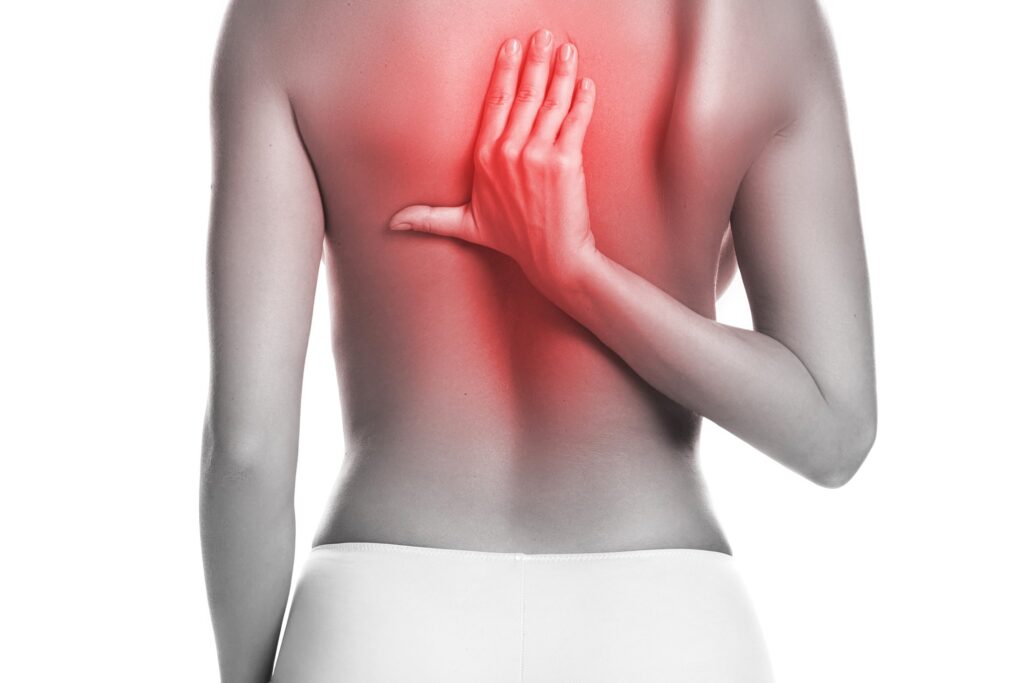How to Relieve Upper Back Pain in Chicago
 What is Upper and Middle Back Pain?
What is Upper and Middle Back Pain?
Upper and middle back pain can occur anywhere from the base of the neck to the bottom of the rib cage.
The ribs are attached to a long, flat bone in the center of the chest, called the sternum, and are attached to and surround the back. If a nerve in this area is pinched, irritated, or injured, you may also feel pain in other places the nerves pass through, such as your arms, legs, chest, and abdomen.
The upper and middle part of the back (which is called the thoracic spine) have:
- 12 vertebrae. These bones connect to the rib cage. They make up the longest part of the back.
- Discs that separate each vertebra and cushion the impact when you move.
- Muscles and ligaments that provide support to the spine.
Upper and middle back pain is not as common as low back pain or neck pain, because the bones in this area of the back do not flex and move as much as the bones in the lower back or neck. Instead, they work with the ribs to maintain stability in the back and to help protect vital organs, such as the heart and lungs.
What is the Cause of Upper and Middle Back Pain in Chicago?
Upper and middle back pain may be caused by:
- Overuse, muscle strain, or injury to the muscles, ligaments, and discs that support the spine.
- Bad posture.
- Pressure on the spinal nerves from certain problems, such as a herniated disc.
- Fracture of one of the vertebrae.
- Osteoarthritis caused by the breakdown of the cartilage that cushions the small facet joints in the spine.
- Myofascial pain that affects the connective tissue of a muscle or group of muscles.
- Rarely, the pain may be caused by other problems, such as gallbladder disease, cancer, or infection.
What are the Symptoms of Upper Back Pain in Chicago?
Common symptoms of upper and middle back pain are:
- A dull, burning, or sharp pain.
- Muscle tightness or stiffness.
More serious symptoms that need to be treated right away include:
- Weakness in the arms or legs.
- Numbness or tingling in the arms, legs, chest, or abdomen.
- Loss of bowel or bladder control.
How is Upper and Mid Back Pain Diagnosed in Chicago?
Your doctor will first ask about your health history, your symptoms, your job, and your physical activities. Then they will do a physical exam. Your doctor might also order an imaging test, such as an X-ray or MRI, to find out if, for example, a broken bone or herniated disc are causing your pain.
You may need to have more tests to check for other possible causes of your pain.
How is Upper Back Pain Treated in Chicago?
In most cases, people with mild to moderate back pain can manage their symptoms with:
Over-the-counter pain relievers, such as acetaminophen (for example, Tylenol) and nonsteroidal anti-inflammatory drugs (for example, Advil, Aleve, aspirin, and Motrin).
Heat or ice.
Do exercise.
Manual therapy, such as massage, mobilization, or manipulation of the spine.
But if your pain gets worse and you’re having trouble doing your usual activities, you may need to take a prescription pain reliever. Surgery is rarely used to treat upper and middle back pain.
Conclusion
If you have questions or would like to meet with one of our doctors, please contact our chiropractors in Chicago to get the appropriate treatment for you. Call or contact us today to schedule an appointment.